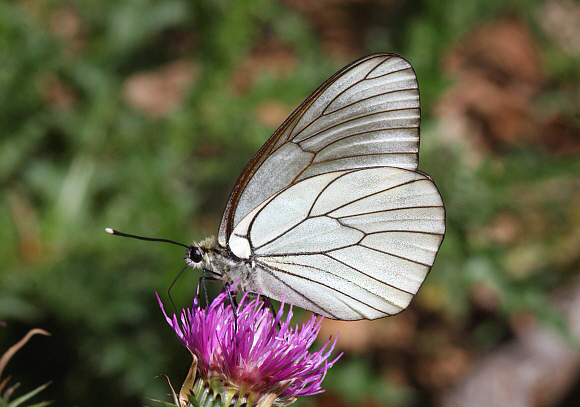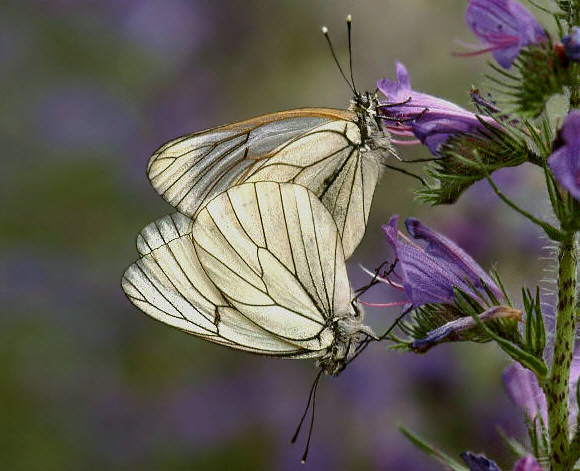 Aporia crataegi, Krasno Polje, Velebit mountains, Croatia – Peter Bruce-Jones
Aporia crataegi, Krasno Polje, Velebit mountains, Croatia – Peter Bruce-Jones
Introduction
There are 30 species of Aporia, the majority of which are limited to Tibet, Mongolia and China. Aporia crataegi is by far the commonest and most widespread member of the genus, being found from Spain and North Africa, across Europe and temperate Asia to Kamchatka and Japan.
Black-veined Whites were also once common in southern England, where there were at least 50 resident colonies, reinforced by regular immigrations from Europe. In the early 1920s however the butterflies suddenly disappeared. Various theories for the extinction were put forward, including unsuitably mild winters, parasitism, bird predation and the use of herbicides in orchards, but the real explanation remains unknown, and despite several attempted reintroductions the species has failed to re-establish itself in Britain.
 Aporia crataegi, Ravni Dabar, Velebit mountains, Croatia – Peter Bruce-Jones
Aporia crataegi, Ravni Dabar, Velebit mountains, Croatia – Peter Bruce-Jones
Habitats
This species is found on scrubby grassland, along roadsides, around woodland and field edges, in sub-alpine woodland / hay meadow mosaics and other open habitats where the foodplants grow. It tends to be most abundant in drier habitats, and can be found at elevations between sea level and about 1600m.
Lifecycle
The eggs are laid in batches of between 50-200 on the underside of leaves of blackthorn bushes Prunus spinosa or more rarely on hawthorn Crataegus ( Rosaceae ). They are spindle-shaped, with numerous vertical ribs, and bright yellow in colour.
The caterpillars hatch in July, feed for a while, and enter hibernation in September. They awaken and resume feeding in March or April. Throughout the early instars they live within a communal web of silk, spun on the foodplant. As they grow they split into smaller groups and spin new webs, continuing their gregarious existence until the final instar when they split up and become solitary.
When fully grown the caterpillar is sparsely covered in soft hairs, and is black above, with orange-brown subdorsal stripes. The lower half of the body is off-white.
The chrysalis is attached vertically by the cremaster and a silken girdle to a twig or branch, on or near the foodplant. It is white, heavily suffused with yellow, with black streaks on the thorax and wing cases, and black spots all over the abdomen.
The adults fly from May to early August.

Aporia crataegi, Meribel les Allues, la Vanoise, France – Adrian Hoskins
Adult behaviour
Both sexes nectar at a wide variety of flowers including ox-eye daisies, scabious, thistles, clovers, vipers bugloss, self-heal, valerian, lavender and various vetches.
Males commonly visit sources of mineral-rich moisture such as urine-tainted soil, dung, and the edges of shallow stagnant pools. In Siberia the butterflies often aggregate in thousands to drink at the edges of shallow streams.
I have not observed the courtship, but have often found copulated pairs late in the morning, sitting on flowerheads. The butterflies are quite nervous – if disturbed while mating they take flight, with the male carrying the female. They usually resettle a short distance away on another flower head.
It is interesting to note the roosting behaviour of this species. In Provence e.g. I visited a meadow on a warm sunny day in August when hundreds of crataegi could be seen flying. The next morning however saw a dramatic change in the weather – the wind direction changed, funnelling the freezing gale-force winds of the Mistral through the valley. I visited the meadow again, hardly expecting to be able to find a single butterfly, but was amazed to discover that almost every flower-head held a cluster of 3 or 4 Black-veined Whites, each clinging desperately to their plant, where they remained until the winds dropped and temperatures rose again late in the afternoon.
